
Andrew Corporation – Base Station Systems Group
Proprietary – Use pursuant to Company Instruction
OneBase™ Cell Extender
Model: OBE-DB-X
Operation Instruction
December 20, 2006
Version. 1.0
Reference Numbers:
FCC ID: S8L-OBEMCPA
IC:2237F-OBEMCPA

Andrew Corporation – Base Station Systems Group Page 1
Proprietary – Use pursuant to Company Instruction
Introduction:
The OneBase™ Cell Extender subrack is a high-power, mixed-mode RF front-end
equipment solution which provides signal amplification and conditioning for both uplink
and downlink cellular base station signals. It is a highly modular design, consisting of a
minimal set of unique field-replaceable units, capable of being configured and scaled for
a variety of system level capacities and air interfaces including TDMA, GSM/EDGE,
CDMA, WCDMA and analog air interfaces.
System Specifications:
System specifications for the OneBase™ Cell Extender Subrack are:
Parameter Specification
Frequency Bands 850 MHz Band Tx: 869-894 MHz
1900 MHz Band Tx: 1930-1990 MHz
25 MHz (29 MHz for -20dB bandwidth, nominal) Operation Bandwidth
60 MHz (70 MHz for -20dB bandwidth, nominal)
Input / Output Impedances 50 Ohms
Supply Voltage +21 VDC to +30 VDC
Nominal Passband Gain (dB) 55 dB +/- 1 dB
Power Amplifier Module Power
Rating
135 Watts
Subrack Capacity 4 MCPAs
Total Rated Mean Output Power 426 Watts (+56.3 dBm)
Supported Output Power (Typical) 40 Watts/carrier (WCDMA)
25 Watts/carrier (TDMA)
25 Watts/carrier (CDMA)
25 Watts/carrier (GSM/EDGE)
DC current draw <140 Amps per Subrack
In-Band emissions -13 dBm/MHz
Receive Path Noise Figure 3.5 dB

Andrew Corporation – Base Station Systems Group Page 2
Proprietary – Use pursuant to Company Instruction
Functional Blocks:
The OneBase™ Cell Extender subrack is comprised of the following functional blocks:
− RFIM (Radio Frequency Interface Module):
− MCPAs (Multi-carrier Power Amplifiers—850 MHz or 1900 MHz)
− SCM (Switch Combiner Module)
− Filter Module (850 MHz or 1900 MHz)
− PDP (Power Distribution Panel)
− Inputs and Outputs
Inputs and Outputs:
The amplifier is powered from a DC supply voltage which can range from 20VDC-to-
30VDC (with a nominal voltage of 27 VDC). The DC power is brought into the subrack
at a terminal that is in the back of the subrack.
The RF signal is brought into the RFIM, passes into the amplifers, then through the SCM
which is blind-mate connected to the amplifiers, and finally into the Filter Modules and
subsequent antenna ports.

Andrew Corporation – Base Station Systems Group Page 3
Proprietary – Use pursuant to Company Instruction
System Pictures:
Front View
Rear View

Andrew Corporation – Base Station Systems Group Page 4
Proprietary – Use pursuant to Company Instruction
Alarm System:
Alarms and operating state are communicated to the BTS via connections to the “Alarm
Terminal Block” at the back of the subrack. The terminal block is internally connected to
dry-contact relays which are located in the MCPA subracks.
ALARM
CATEGORY
SEVERITY
Minor
Conditions that do not immediately affect system operation, but lead to more serious problems if
ignored.
Major
Conditions that directly affect amplifier operation (e.g. reduced gain), but allow the system to
continue operating.
Critical Conditions which result in sector shutdown, preventing any further cellular call traffic.
MCPA LEDs
MCPA LED
Status
Alarm Severity Possible Failure Modes
Green: “ON”
Yellow: ON”
Red: “ON”
Initial Power-up of
MCPAs.
NONE
LEDs all “ON” simultaneously for about 2 seconds.
Green: “ON” Normal Operation NONE
Green: “ON”
Yellow: ON”
Minor
1. MCPA Fan(s) failure
2. MCPA high internal temperature (approximately between 80°C
and 90°C).
3. MCPA values indicating: Poor Return Loss (3-8 dB)
Yellow: ON”
Major
1. RF disabled via MCPA panel switch or RFIM command
2. RF Overdrive (gain reduced)
3. DC voltage out of normal range
Red: “ON”
Critical
1. MCPA internal failure
2. RF Overdrive (> 10 dB)
3. MCPA high internal temperature
(above approximately 90°C).
4. MCPA values indicating: Poor Return Loss (0-3 dB)

Andrew Corporation – Base Station Systems Group Page 5
Proprietary – Use pursuant to Company Instruction
RFIM LEDs
RFIM LED Status Alarm Severity Possible Failure Modes
Green: “ON”
Yellow: “ON”
Red: “ON”
Initial Power-up of
MCPAs.
NONE
Green: “ON”
Yellow: “FLASHING”
Booting or remote
loading of RFIM
Firmware
NONE
Green: “ON” Normal Operation NONE
Green: “ON”
Yellow: “ON”
Minor
1. RFIM internal temperature high (over approximately 75°C)
2. “Minor” failure from one or more MCPAs as follows:
a. MCPA Fan(s) failure
b. MCPA high internal temperature (approximately
between 80°C and 90°C)
c. MCPA values indicating: Poor Return Loss (3–8 dB)
3. Filter Module high internal temperature (above
approximately 80°C)
Green: “ON”
Red: “FLASHING”
Major
1. “Major” failure or one or more MCPAs as follows:
a. RF disabled via MCPA panel switch or RFIM command
b. RF Overdrive (gain reduced)
c. DC voltage our of normal range
2. Communications problem from RFIM to Filter Module.
3. Filter Module current out of range.
Green: “ON”
Red: “ON”
Critical
1. RFIM self test fails.
2. RFIM internal regulators failed.
3. Filter Module missing or loose. Filter Module thumbscrew(s)
not tight. Filter Module thumbscrew switch “OPEN”.
4. Filter Module indicating: Poor Return Loss (0-3 dB)
5. Sector cannot process traffic (i.e. MCPA module(s) failure).
FILTER MODULE LEDs
Filter Module LED status Alarm Severity Possible Failure Modes
Green #1: “ON”
Green #2: “ON”
Normal Operation NONE
Red #1: “ON”
Critical Replace Filter Module
Red #2: “ON”
Critical Replace Filter Module

Andrew Corporation – Base Station Systems Group Page 6
Proprietary – Use pursuant to Company Instruction
Installation and Operation Set-Up
Each OneBase™Cell Extender subrack is specifically designed for a specific cellular
system by using the correct combination of components and the correct electrical wiring
and RF cabling of these components. The components of the OneBase™Cell Extender
subrack are electrically connected with a combination of blind mate rear connections and
front panel connections to optimize flexibility and ease of maintenance.
The MCPA Modules are vertically arranged and blind-mated to their RF and DC/control
interfaces in the rear of the subrack. The RF Interface Module (RFIM) is also vertically
arranged and is located to the right side of the MCPA modules. The Filter Modules are
situated at the top portion of the subrack mounted either vertically or horizontally. The
filters interface to the SCM through blind-mate “N” connectors.
FCC Statements: FCC ID: S8L-OBEMCPA
This device complies with Part 2, 15, 22, and 24 of the FCC Rules. Operation is subject
to the following two conditions: (1) this device may not cause harmful interference and
(2) this device must accept any interference received, including interference that may
cause undesired operation.
Warning
Changes of modifications not expressly approved by the manufacturer could void the
user’s authority to operate the equipment.
RF exposure compliance is addressed at the time of licensing, as required by the
responsible FCC Bureau(s), including antenna co-location requirements of 1.1307(b)(3).
Industry Canada Statements: IC:2237F-OBEMCPA
1. Quality Norms : The testing of the equipment is carried out as the norms laid in IC
standards.
2. Labeling : OneBase™ Cell Extender subrack when sold in Canada will have:
(a) The certification number, prefixed by the term "IC: ", i.e. IC:2237F-OBEMCPA
(b) The manufacturer's name, trade name or brand name, i.e. Andrew Corporation
(c) A model name or number. Model Name = OneBase™ Cell Extender
(d) This device complies with RSS-131, RSS-102 of the IC Rules.
3. External Control
The OneBase™ Cell Extender subrack does not have any external controls accessible to
the user for any adjustments, to operate in violation of the limits prescribed in this
Standard. Furthermore, information on internal adjustments, reconfiguration or

Andrew Corporation – Base Station Systems Group Page 7
Proprietary – Use pursuant to Company Instruction
programmability of the device shall only be made available to service depots and agents
of the equipment supplier and NOT to the public.
4. Exposure of Humans to RF Field : The equipment conforms to RSS-102. RF
Exposure compliance is also addressed at the time of licensing.
5. Multi-carrier operation : Rated output power of the equipment is for multi-carrier
operation, which is 426 Watts maximum total composite. For multiple carriers, the total
output power is distributed as required for each RF carrier. The rating per carrier is
reduced so the total output power is not exceeded. While there is a possibility of single-
carrier use, the maximum output power shall still not exceed 426 Watts. In fact, typical
usage for various carriers is usually no greater than 50 Watts per carrier (see
Specification table).
-
 1
1
-
 2
2
-
 3
3
-
 4
4
-
 5
5
-
 6
6
-
 7
7
-
 8
8
Andrew S8L-OBEMCPA User manual
- Type
- User manual
- This manual is also suitable for
Ask a question and I''ll find the answer in the document
Finding information in a document is now easier with AI
Related papers
-
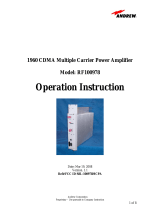 Andrew Corporation S8L-100978MCPA User manual
Andrew Corporation S8L-100978MCPA User manual
-
Andrew Corporation S8L-100254MCPA User manual
-
Andrew Wireless System Node C User manual
-
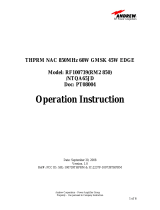 Andrew Corporation S8L-100739THPRM User manual
Andrew Corporation S8L-100739THPRM User manual
-
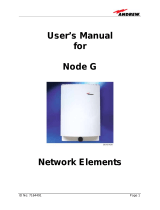 Andrew Node G 930 User manual
Andrew Node G 930 User manual
-
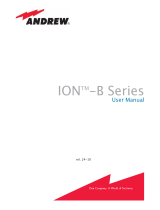 Andrew BCR-TFAHUS5 User manual
Andrew BCR-TFAHUS5 User manual
-
Andrew Wireless System ION-M7P User manual
-
 Andrew Multimode Power Distribution Unit User guide
Andrew Multimode Power Distribution Unit User guide
Other documents
-
Dante DFC9200 Series Operating instructions
-
Ericsson 1/KRB 101 1108 Installation, Operation And Maintenance Instructions
-
Powerwave Technologies E675JS0105 User manual
-
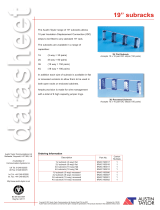 Austin Taylor 9RAC193818 Datasheet
Austin Taylor 9RAC193818 Datasheet
-
Promax DT-900 User manual
-
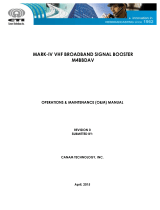 Canam Technology TCJ-M4BBDAV User manual
Canam Technology TCJ-M4BBDAV User manual
-
ADC Digivance NXD Installation and Maintenance Manual
-
ABB FOX615 Installation & User Manual
-
COBHAM BSF0060 User Handbook Manual
-
ADC Network Router NXD User manual














